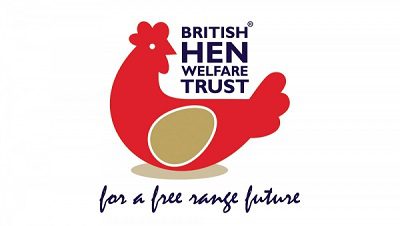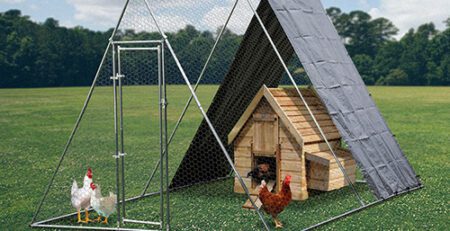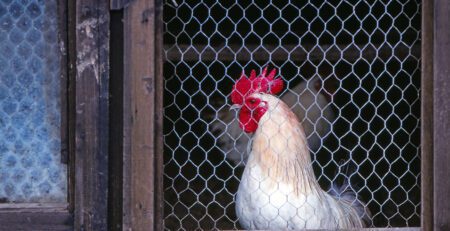Chicken Runs for Security
Summer is here and the governments have lifted avian flu restrictions in most places for several weeks. This means that you do not have to keep your chickens in an enclosure all of the time. This is good news for many owners of back yard chickens who want to give their birds a life that is very different from that experienced by those in battery type conditions. Indeed, as we have mentioned in the blog in the past, many people get their chickens from rescue organisations. These charities do their best to give battery hens a chance of a better life. Birds that are past their peak laying age are re-homed where they will have more freedom.
Chickens need a coop for shelter and security at night. Many owners do like to let their hens free range at least some of the time. Most though will have some kind of enclosure to keep their birds safe whilst also giving them plenty of room for exercise. A well constructed chicken run will keep the flock safe from harm. Birds that are completely free range, especially when left unattended, are more vulnerable to predators. They may also wander off.
Chicken Run Construction
The exact size of the the run will vary according to the size of the flock. and also the size of the birds. Some breeds are much bigger than others, and need more space. Then there is the question of construction type and materials.
There are those who will chose to build their own chicken run. In this case a wooden frame is popular. Wood is easily available but good quality wood is not cheap. There are also long term maintenance issues to consider. Rain and wind will take their toll and over time wooden frames will be prone to rot. There is also the issue of keeping the wire firmly attached to the frame. As the wood weakens, it will become easier for predators such as foxes to tug at the wire and pull it away from the frame. Foxes can squeeze through surprisingly small gaps.
It is essential therefore that people carry out regular checks and maintenance to ensure that the enclosure remains secure. Pay attention in particular to the points where you have attached the wire to the frame. Make sure that it remains firmly attached and that no gaps are opening up.
Covering your Chicken Run
It is also essential to consider how to cover the run. The chickens will be spending the night safely inside their coop of course. The coop may be inside the run, or located at one end of the run, accessed through a gap in the wire. If the second option is chosen, this is another place where it is important to ensure that the joins are secure. In any event though the run should still be at least partly covered.
A cover on the run will provide shade in hot weather and shelter from rain. This will help to prevent the inside of the run from becoming too muddy during wet weather. Avian flu is also a consideration. The authorities may have removed restrictions but the experience of recent years suggests that they are likely to return later in the year. Some people used fine mesh netting to cover their runs during the outbreak. The advantage of a waterproof cover over netting is that it helps to reduce the chances of rain washing wild bird droppings down into the run.
Regardless of the type of run construction, you should slope the roof to prevent water from pooling on the covers. The weight of snow building up can also be an issue in areas with heavy snowfall. Try to minimise the risk of this.
Alphapet® stock spare and additional covers for all the sizes of run that they sell, including full end covers. Remember though to use a configuration that allows plenty of light and ventilation.
Metal Framed Chicken Runs
Many people now opt for a steel framed walk-in chicken run like those available on the Alphapet® website. These are available in a wide variety of sizes. The smallest sold by Alphapet® are the 2.5mx3m Prism runs whilst the the largest are 4mx8m. Because they are constructed from galvanised steel tubing, these runs are extremely robust and long lasting. They are also simple to construct as the main frame components and joints all clip together easily. The only parts that have to be bolted together are the door and door frame.
As standard, Alphapet® supply chicken runs with sufficient 25mm hexagonal PVC covered chicken wire to cover the exterior with a single layer. They also provide an ample supply of cable ties with which to firmly and securely attach the wire to the frame and the door. As mentioned before, securely attaching the wire to the frame is an absolutely essential part of keeping out predators, regardless of the type of run or materials used.
Alphapet® have recently upgraded the doors that they supply with their three and four metre chicken runs. Square section tubing ensures a narrower gap between frame and door. This helps to make it harder for rats and other pests to get into the run.
Additional security measures
Alphapet® have been supplying walk-in chicken runs for several years and are pleased and grateful to have received great reviews and feedback. Provided that care is taken to securely attach the wire supplied and to check it regularly for signs of wear and damage, then the run will provide good protection.
You can never do too much to make your chicken run secure against predators. The precautions that you take, however, will vary according to local circumstances, prevalence and type of predators etc.
The surface on which you place your chicken run is obviously a factor but many experienced chicken enthusiasts will take measures to discourage foxes from digging their way under and into the run. A row of paving slabs all the way around the outside of the run is a good deterrent. Some people also put slabs down inside the run but remember to leave some earth for the chickens to use as a “dust bath”. Another approach is to lay wire under the earth right across the interior of the run. Some owners who have suffered persistent problems with foxes go as far as to install electric fencing. If you opt to add extra layers of welded wire or rodent mesh to the exterior surfaces of the run, Alphapet® recommends that you do this in addition to, and not instead of using the the standard 25mm PVC coated wire supplied.
Finally, make sure that the door is secure when the chickens are inside. The catches on Alphapet® chicken runs are secure but there is no harm in locking the the run up at night. A nightly locking up routine can help to prevent forgetting to put your birds away at night.









Leave a Reply
You must be logged in to post a comment.